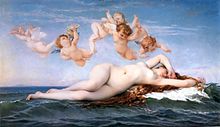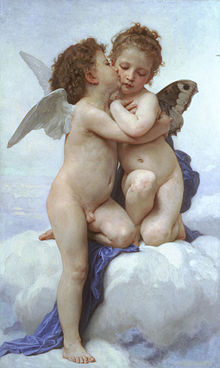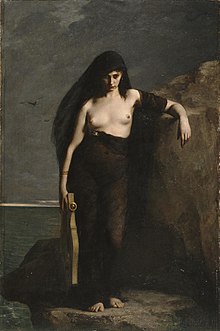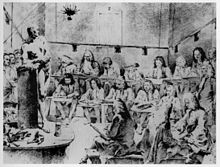Academic art
![]()
This article is about the art style of the fine arts in the 19th century, for the extended environment see Academism
Academic Art (also called Academic Realism or Academicism, more rarely Academicism or also Salon Painting) was a European art style from the 17th to the 19th century. It placed its emphasis on strict adherence to the formal technical and aesthetic rules of the art academies.
Academic art includes paintings and sculptures created under the influence of the European academies, where many artists of the time received their formal training. Academic art was based on a predominantly literary, mythological and historically motivated canon of permissible or desirable themes. Its artists rarely showed interest in depicting the mundane or profane. Thus, Academic Art is predominantly idealistic rather than realistic.
Stylistically, academic art cultivated the ideal of perfect and at the same time selective imitation of reality (mimesis) that had existed since Aristotle. With perfect mastery of color, light and shadow, forms were worked out quasi-photorealistically. Some paintings show a "polished finish" in which no brushstroke can be discerned in the finished work. This ideal of art was shaken to its foundations in the mid-19th century by the invention of photography.
Particularly formative for the style was the French École des Beaux-Arts, which was under the influence of Neoclassicism and Romanticism. The Academic Art of later times synthesized these two styles, which can be seen very well in the paintings of William Adolphe Bouguereau, Thomas Couture and Hans Makart.
With the advent of later art styles, especially Impressionism, Academic Art was scorned and dismissed as "eclecticism". From the beginning to the end of the 20th century, it was not considered worthy of attention by most art experts, so it was barely mentioned and disappeared into museum repositories; occasionally it was disparagingly called "art pompier". The academic style of painting was further discredited by the fact that it was elevated to an absolute standard by National Socialist art policy. Only a few, mostly older artists remained faithful to it until the 1960s.
It was not until the 1990s that fin de siècle academic art was gradually "rediscovered" and has since been gaining increasing esteem again. While painting, reflecting on and questioning its own presuppositions, went its own way, historical film in particular, especially the sandal film, continued academism's desire to reconstruct the past.

The Birth of Venus by Alexandre Cabanel

L'Amour et Psyche, enfants by William Adolphe Bouguereau

Charles-August Mengin: Sappho, 1877. Manchester Art Gallery
.jpg)
Art students painting nudes at the École des Beaux-Arts, late 19th century

Nude study in an academy around 1720, Giovanni Battista Tiepolo
Important representatives
- France
- Louis-Ernest Barrias, sculptor
- Paul Baudry, painter
- Léon Bonnat, painter
- William Adolphe Bouguereau, painter
- Jules Breton, painter
- Alexandre Cabanel, painter
- Albert-Ernest Carrier-Belleuse, sculptor
- Charles Joshua Chaplin, painter
- Thomas Couture, painter
- Alexandre-Gabriel Decamps, painter
- Paul Delaroche, painter
- Émilie Desjeux, painter and portraitist
- Alexandre Falguière, sculptor
- Jean-Léon Gérôme, painter and sculptor
- Jean Jacques Henner, painter
- Marius Jean Antonin Mercié, sculptor
- Aimé Morot, painter
- Isidore Pils, painter
- Georges-Antoine Rochegrosse, painter
- Jean Victor Schnetz, painter
- Belgium
- Hendrik Leys, painter
- Alfred Stevens, painter
- Germany
- Anselm Feuerbach, painter
- Wilhelm von Kaulbach, painter
- Franz von Lenbach, painter
- Karl von Piloty, painter
- England
- Sir Lawrence Alma-Tadema, painter
- Sir Alfred Gilbert, sculptor
- John William Godward, painter
- Frederic Leighton, painter and sculptor
- Albert Joseph Moore, painter
- George Frederic Watts, painter
- Greece
- Georgios Jakobides, painter
- Netherlands
- Ary Scheffer, etcher and sculptor
- Austria
- Hans Canon, painter
- Hans Makart, painter
- Viktor Tilgner, sculptor
- Bohemia
- Václav Brožík, painter
- Josef Malinský, sculptor and carver
- Poland
- Henryk Siemiradzki, painter
- Russia
- Karl Bryullov, painter
- Alexander Ivanov, painter
- Konstantin Makowski, painter
- Switzerland
- Charles Gleyre, painter
- Spain
- Marià Fortuny, painter
- Italy
- Francesco Hayez, painter
Search within the encyclopedia